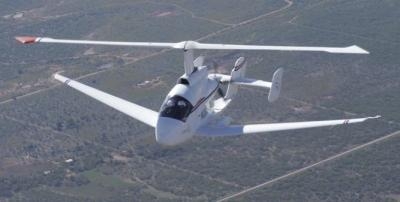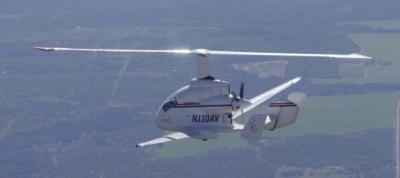Proof Of Concept VTOL Aircraft Undergoing 'Conservative' Trials
Working in conjunction with Carter Aerospace Development, Carter Aviation Technologies says it has made significant progress as performance flight-testing of the current prototype, the Proof of Concept demonstrator (the “POC”), continues. The POC is a variant of the company’s four passenger vertical takeoff and landing (“VTOL”) aircraft, known as the SR/C 4-Place PAV.

The company says the POC is continuing to expand the high speed/slowed rotor envelope. Over the last month, conservative performance flight-testing has yielded the following results:
- Lift-to-drag (“L/D”) values of 10-12 at high speed cruise at a test weight of 3,950 lbs – around two to two-and-a-half times better than the most efficient helicopters. L/D is a measure of the efficiency of an aircraft. Higher L/D ratios are one of the primary goals in aircraft design, inasmuch as an aircraft’s required lift is determined by its weight, delivering that lift with decreased drag leads directly to enhanced speed, fuel economy, climb performance, and glide ratio.
- Speeds of 160 mph at 200 HP (with this configuration expected to exceed 235 mph at 25,000 feet & 350 HP)
- Altitude of 12,000 feet
- Flight with the rotor slowed to 106 rpm
Thus far, an advance ratio of 0.85. The advance ratio is calculated by dividing the forward airspeed of the aircraft by the tip speed of the rotor. As the rotor rpm (i.e., the tip speed) is reduced, the advance ratio increases. As the advance ratio increases, drag on the rotor decreases dramatically (resulting in increased efficiency).

Additionally, jump takeoffs are now routine and used in virtually every test flight.
The company plans to continue to expand the high speed/slowed rotor envelope in the coming weeks, and will gather more data on flight efficiencies under those conditions.
Carter Aviation's technical achievements have been independently verified by NASA, the U.S. Army, and the nation’s top Center for Rotorcraft Excellence at the Georgia Institute of Technology. Its SR/C aircraft are protected by more than 20 U.S. patents, many of which have also been filed in foreign patent offices.
The company projects that the, SR/C aircraft will have 3 to 6 times the range of helicopters (and 300% to 600% lower fuel consumption); offer cruise speeds from 150 mph at low altitudes to 500 mph at 40,000 feet; have the ability to operate without runways at low cost, which will revolutionize regional civilian air transportation; will be the the only aircraft capable of transporting large payloads over long ranges to sites requiring VTOL, where local fuel is either very expensive or unavailable; are inherently safe and capable of flight even if all electronic systems fail, and, in the event of fuel exhaustion, normal landings remain possible; and could be scaled in size from small unmanned aerial vehicles (UAVs) to a Boeing 767 equivalent.
(Images provided by Carter Aviation)
 ANN's Daily Aero-Linx (05.02.24)
ANN's Daily Aero-Linx (05.02.24) ANN's Daily Aero-Term (05.02.24): Touchdown Zone Lighting
ANN's Daily Aero-Term (05.02.24): Touchdown Zone Lighting Aero-News: Quote of the Day (05.02.24)
Aero-News: Quote of the Day (05.02.24) ANN FAQ: Contributing To Aero-TV
ANN FAQ: Contributing To Aero-TV NTSB Final Report: Cirrus Design Corp SR20
NTSB Final Report: Cirrus Design Corp SR20




